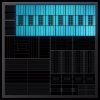Apple recently announced they're moving from x86 to Arm on Macs too. They've now also released a video, which confirms they'll move to their own GPUs too.
https://developer.apple.com/videos/play/wwdc2020/10631
Details of the architecture are of course still limited other than it's TBDR. With Apples licensing deal with Imagination, it's however quite surely PowerVR-based just like their mobile GPUs.
This could also explain why Imagination/PowerVR was looking again at high-performance GPUs a little while back
https://developer.apple.com/videos/play/wwdc2020/10631
Details of the architecture are of course still limited other than it's TBDR. With Apples licensing deal with Imagination, it's however quite surely PowerVR-based just like their mobile GPUs.
This could also explain why Imagination/PowerVR was looking again at high-performance GPUs a little while back

